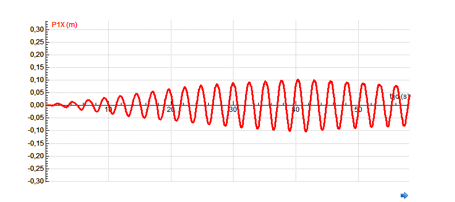| Learning Aims: |
|
| Materials |
| A Heavy object (approx. 5 kg – 10 kg) and double rope (to stabilize the motion) |
| Suggestions for use: |
|
In this activity students try to get a heavy object to oscillate by blowing and answer the question: how can it be that such a small force results in such strong effect? See for a demonstration of this experiment: http://youtu.be/zqhF7NEOStY It should be enough to do this experiment two or three times, with different teams of two- three students. Try to see how the students work together and check if the team that has a student on each side of the swinging object gets larger amplitude. This experiment is also available as Coach data video activity. Students that are not able to do the experiment might want to work with this activity. The figure below shows the graph of a heavy bag oscillating (5 kg). A graph like this might be used as a basis for assessment questions. If students are familiar with the theory (and the relation between length of the rope and the frequency), they might want to calculate the length of the ropes used.
Position of the heavy object oscillating. Another way to determine the frequency of the movement is by analysing the sound file of the YouTube movie. Every blow is easy to recognize and since the blows are in the right frequency, the frequency of the vibration can be derived from this sound file.
The sound file of the movie of this experiment. Another example of resonance might be the Chladni experiment: http://www.youtube.com/watch?v=Zkox6niJ1Wc. See for more information: http://hyperphysics.phy-astr.gsu.edu/hbase/sound/reson.html#resdef or http://en.wikipedia.org/wiki/Resonance |
| Possible questions: |
|

